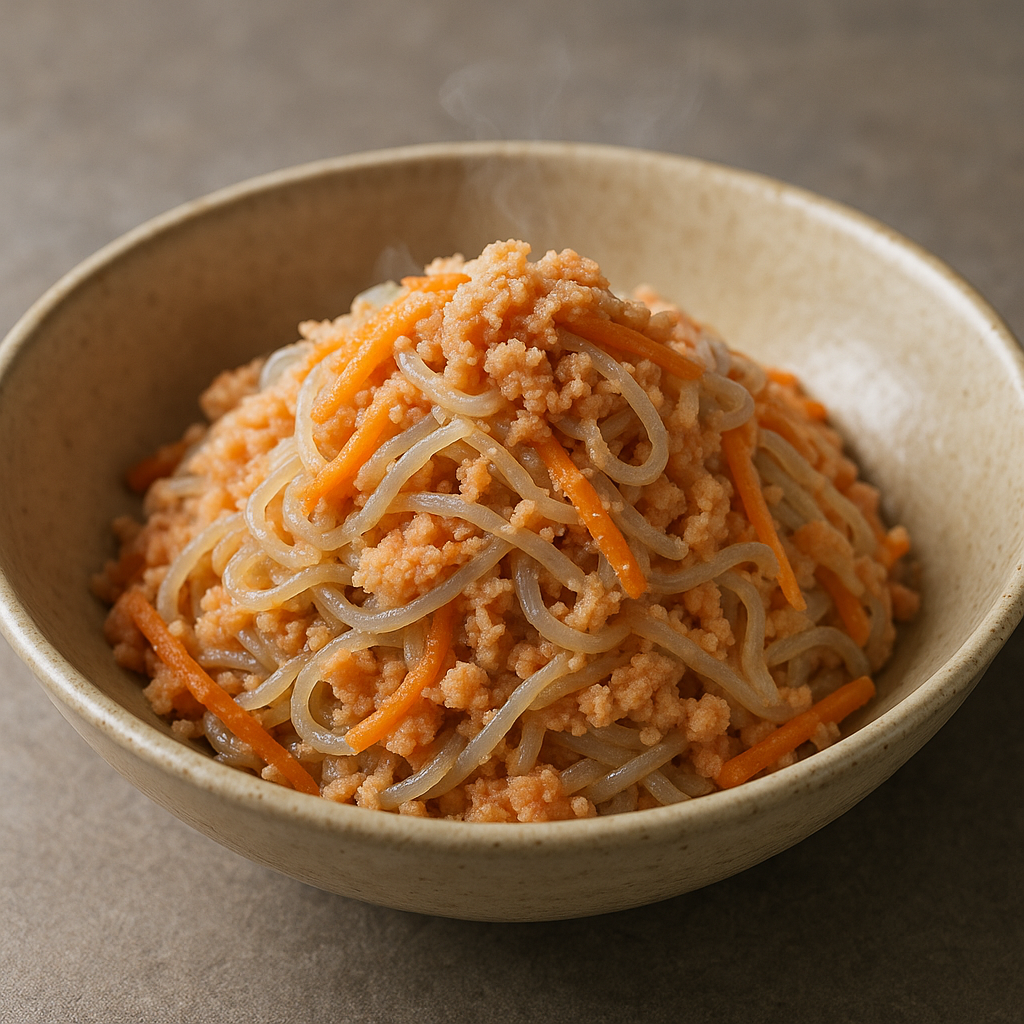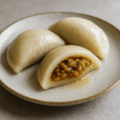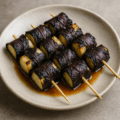たらの子和えの特徴
冬のごちそう、正月の定番おかず
青森の冬に親しまれる家庭料理で、年末に買い求めた真鱈の「生たらこ」を使う正月料理のひとつ。地域ページでも“正月にタラは欠かせない”と紹介されています。
生たらこを“炒り和え”に
生たらこをほぐし、にんじんや糸こんにゃく、高野豆腐、ねぎと合わせて軽く煮炒りして仕上げます。素朴ながら後を引く味わいで、「じゃっぱ汁」と並ぶ冬の鱈料理として知られます。
呼び名と広がり
真鱈の卵を用いる食文化は北東北に広く、秋田の「鱈の子炒り」など名称違いも。青森では「子和え」と呼ばれて受け継がれています。
たらの子和えのレシピ
材料(4人分)
- 生たらこ(真鱈) … 200g(軽く下処理:塩少々 or 酒少々で10分)
- にんじん … 120g(細切り)
- 糸こんにゃく … 150g(下ゆでして食べやすく切る)
- サラダ油 … 小さじ2
調味
- 酒 … 50ml
- 醤油 … 大さじ2
- みりん … 大さじ1(お好みで)
作り方
- 下ごしらえ:生たらこは薄皮を外しやすいよう軽く塩(または酒)をふって10分置き、ほぐす。糸こんにゃくは下ゆでして臭みを抜く。
- 炒める:鍋に油を熱し、にんじんをさっと炒める。糸こんにゃくを加えて水分を飛ばす。
- 煮炒り:ほぐした生たらこを加え、酒→醤油→みりんの順で調味。弱めの中火で水分が少し残る程度までそっと炒りつける。
- 仕上げ:汁気が多ければ弱火で軽く飛ばし、味を調整する。
シェフのワンポイントアドバイス
生たらこは強火で混ぜすぎないのがコツ。粒立ちが残る程度にやさしく。糸こんにゃくは先に乾煎りしておくと水っぽくなりません。
高野豆腐はしっかり水切りする事で味がぼけず、仕上がりが締まります。
栄養価(1人分の目安)
- エネルギー:約180〜260 kcal
- たんぱく質:12〜18 g
- 脂質:6〜12 g
- 炭水化物:10〜20 g
高たんぱくでミネラルも含む一品。塩分は醤油量で調整しやすいです。
歴史
正月の“鱈料理”として家庭に定着
年の瀬に大ぶりの鱈を買い、正月のごちそうとして食べた名残から、冬の定番おかずとして根づきました。
北東北に広がる真鱈の卵食文化
秋田や山形でも似た料理が伝わり、名称や具材の違いを楽しめます。
English Version
Features of “Tara no Ko-ae” (Cod Roe Toss)
A Winter Treat and New Year’s Staple
A beloved home dish in Aomori’s winter, this New Year’s side uses fresh cod roe (nama-tarako) bought at year’s end. Local guides even note that “cod is indispensable for the New Year.”
Gently “Stirred & Simmered” Fresh Cod Roe
Loosen fresh cod roe and lightly simmer-stir it with carrot, ito-konnyaku (shirataki), and green onion (or tofu/dried tofu variants). Simple yet addictive, it stands alongside jappa-jiru as a classic winter cod dish.
Names and Regional Spread
The custom of cooking Pacific cod roe is found across northern Tōhoku—Akita has a similar dish called “tara no ko-iri.” In Aomori it’s handed down as “ko-ae.”
Recipe
Ingredients (serves 4)
- Fresh cod roe (nama-tarako) … 200 g (pre-treat with a little salt or sake for 10 min)
- Carrot … 120 g (julienned)
- Shirataki (ito-konnyaku) … 150 g (parboil; cut to bite-size)
- Neutral oil … 2 tsp
Seasoning
- Sake … 50 ml
- Soy sauce … 2 tbsp
- Mirin … 1 tbsp (optional)
Instructions
- Prep: To help remove the thin skin, sprinkle the roe lightly with salt (or sake) and rest 10 minutes, then flake gently. Parboil shirataki to remove odor.
- Sauté: Heat oil; sauté carrot briefly. Add shirataki and cook off excess moisture.
- Stir-simmer: Add flaked roe. Season in order—sake → soy sauce → mirin—and cook over medium-low heat, stirring gently until a little moisture remains.
- Finish: If too wet, simmer briefly to reduce; adjust seasoning to taste.
Chef’s Tip
Handle roe gently and avoid high heat to keep the grains intact. Dry-sauté shirataki first so the dish doesn’t get watery. If adding freeze-dried tofu, press out moisture well so flavors don’t dull.
Nutritional Value (per person, approx.)
- Calories: 180–260 kcal
- Protein: 12–18 g
- Fat: 6–12 g
- Carbohydrates: 10–20 g
High in protein with useful minerals. Salt is easy to manage by adjusting soy sauce.
History
Settled as a New Year’s Cod Dish at Home
Families once bought whole cod at year’s end; the tradition remains in this winter staple.
Cod Roe Traditions Across Northern Tōhoku
Similar dishes appear in Akita and Yamagata, with variations in names and ingredients that reflect each locale.



何でも質問してください!